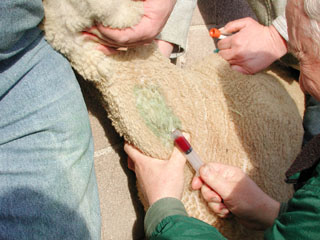
| Obtaining a blood sample from a jugular vein. |
Bacteria Culture and Sensitivity:
When a bacterial infectious agent is suspected, it is recommended that a culture and sensitivity be performed. Problems such as scours, adult diarrhea, abortions, pneumonia, and severe abscess outbreaks are reasons to use a culture and sensitivity to look for a possible bacterial cause. Samples used for culture and sensitivity include the following:* Acquiring and handling these types of samples may require special training and a veterinarianís assistance.
To perform a culture, take one of the above samples and send it to the appropriate laboratory as quickly as possible. At the lab, the sample is placed on a culture medium and allowed to grow. Identifying the bacteria is based on the growth characteristics of the bacteria on the particular culture medium, microscopic examination, and other procedures. Once the type of bacteria is determined, it is subjected to several different antibiotics. Sensitivity is determined by how the bacteria respond to the antibiotics. Sensitivities are reported as Resistant, Sensitive, and Intermediate. Resistant means the particular antibiotic is not effective against that bacteria. Sensitive means the particular antibiotic is effective against that bacteria, and Intermediate means the antibiotic is moderately effective against that bacteria. The appropriate treatment for the problem can then be initiated without trying to guess which antibiotic may or may not work.
Serology and Virus Isolation:
When a viral cause of disease is suspected, it is recommended that the virus be identified. Problems such as pneumonia, abortions, and scours are reasons to identify the possible viral cause.Once a virus has been identified as the problem, appropriate measures, such as herd vaccination and/or culling of affected animals, can be initiated.
 |
|